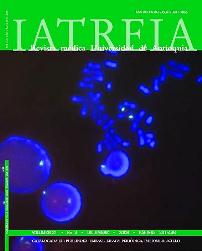Clinical, neuropsychological and sociodemographic characteristics of male children with attention deficit/hyperactivity disorder, with predominance of inattention, in Medellín, Colombia, 2004-2005
DOI:
https://doi.org/10.17533/udea.iatreia.4530Keywords:
Attention deficit/hyperactivity disorder, Children, Executive function, Inattention, Inattentive type of Attention deficit/hyperactivity disorder, NeuropsychologyAbstract
Attention-deficit hyperactivity disorder (ADHD) with predominance of inattention is one of the most common neurobehavioral disorders during childhood, and a frequent reason for consultation. It is characterized by basic alterations in the executive functions and by behavioral inhibition.
Objective: to describe the neuropsychological and sociodemographic characteristics of a group of predominantly-inattentive boys with ADHD, in Medellín, Colombia.
Patients and methods: 16 boys, aged 7 to 11, were selected on the basis of the DSM IV checklist for the inattentive type of ADHD. The following variables were taken into account: age, socioeconomic stratum, reason for consultation, schooling, personal and familial background, development, family typology, and soft neurological signs. The neuropsychological characteristics were evaluated with a battery of psychometric tests that included: the Wechsler´s Intelligence Scale for children (WISC-R) with measurements to determine the Estimated Intellectual Coefficient (IC). The Attention test of the Luria-DNA battery in order to evaluate attention and mental control. The Wisconsin Card Sorting Test (WCST) to measure the executive function. The Stroop test for behavioral inhibition. The Woodcock Munoz (WM) cognitive hability battery subtests Visual Matching, and Cross out, to evaluate the speed of processing and selective focalization; also the Analysis-Synthesis and Concept formation that evaluate the executive function. Two subtests of KABC test were also included, namely: Hand movements to evaluate sequential processing, and Word order to measure interference control.
Results: in the Visual matching subtest of the WM battery, we found that 6 out of the 16 boys (37.5%) were at risk and that 3 (18.8%) were clinically significative. In the dimension Learn to learn of the WCST, 6 boys (37.5%) were at risk and clinically significative.
Conclusion: in general, according to the results obtained in the WISC-R, Woodcock-Munoz, Wisconsin and K-ABC, most of our patients were in the average and favorable categories. The tests that identified more at risk and clinically significant situations were those of Woodcock-Munoz and Wisconsin, that evaluate the speed of processing, selective focalization and executive function.
Downloads
Downloads
Published
How to Cite
Issue
Section
License
Papers published in the journal are available for use under the Creative Commons license, specifically Attribution-NonCommercial-ShareAlike 4.0 International.
The papers must be unpublished and sent exclusively to the Journal Iatreia; the author uploading the contribution is required to submit two fully completed formats: article submission and authorship responsibility.














